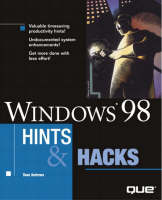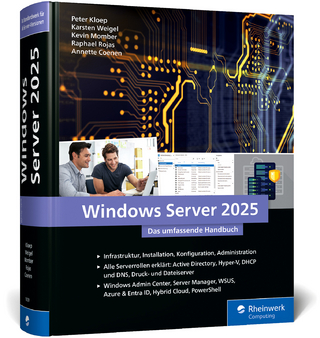
Windows 98 Hints & Hacks
Que Corporation,U.S. (Verlag)
978-0-7897-1750-4 (ISBN)
- Titel ist leider vergriffen;
keine Neuauflage - Artikel merken
PLEASE PROVIDE
Windows 98 Hints & Hacks instantly rewards you by increasing your productivity and satisfaction with Windows 98. Every hint and hack provides real value-- not just a list of obvious items listed as though they were some kind of secret. Windows 98 Hints & Hacks will be divided into several categories: Part 1: Look and Feel Here allows you to control every aspect of your system's appearance and properties. Part 2: Productivity Hints and hacks let you get more work (or play!) done with less effort. Part 3: System Performance How to get the most performance from every application, routine, or procedure. Part 4: Administration provides hints and hacks for users who are in charge of supporting other users (or who just seem to the one people come to with questions).
Dean Andrews is a freelance computer writer living just outside of Boston, MA. He has contributed over 200 articles to many periodicals including Boston Globe Online, PC World Magazine, Macworld Magazine, and The Web Magazine. Dean was also contributing author for Peter Norton¿s Guide to Upgrading and Repairing PCs (Sams) and Using Windows 98 Special Edition (Que).
Introduction.
Who Will Get the Most from This Book? What Windows 98 Adds to Your System. How This Book is Organized. Preparing to Use This Book. What is the Windows Registry? Installing the System Policy Editor. Using Shareware and Freeware from the Web. How to Read This Book.
I. LOOK AND FEEL.
1.1. Change Startup and Shutdown.
Replace the Startup and Shutdown Screens. Replace the Startup and Shutdown Screens. Animate Your Startup Screens. Remove the Login Screen. Boot with Different Operating Systems. Stop Windows from Saving Your Window Locations When You Shut Down. Modify MSDOS.SYS for a Different Look and Feel During Boot. Force Windows to Display a Hardware Configuration Menu.
1.2. Shortcut Savvy.
Set Application Shortcuts to Run in Full-Screen Mode. Make Shortcuts Look Like Standard Icons. Make Your Shortcuts Open Applications and Documents.
1.3. Customizing the Start Menu and Taskbar.
Store More on the Start Menu. Remove Animated "Click here to begin" from the Taskbar. Remove the Favorites Item from the Start Menu. Remove the Log Off Option from the Start Menu. Create Windows Commands that You Launch from the Start Menu.
1.4. Desktop Hints.
Rename System Objects. Remove the Network Neighborhood and Other System Objects from the Desktop. Change Desktop Icons. Squeeze More Icons onto the Desktop. Configure My Computer to Launch Explorer. Modify the New Menu. Transform the Feel of Your Mouse. Bring Back the Program Manager Interface from Windows 3.1.
1.5. Backgrounds.
Make Your Background an HTML File. Get Wallpaper from the Web or the Windows 98 CD. Add Free Utilities to Your Active Desktop. Store Multiple Images on Your Desktop.
1.6. Command Line Coolness.
Change the Font of the MS-DOS Window. Modify the MS-DOS Prompt. Add UNIX Commands to MS-DOS.
1.7. Enhancing Explorer.
Changing the Color of Compressed Files in Explorer. Tell Explorer Where To Go. Add Hyperlinks to Explorer.
1.8. Miscellaneous.
Make Yourself a Ghost. Convert to Metric. Control your video. Change Your Desktop with Every Boot. Make Your Keyboard Sound Off.
1.9. Altering the Active Desktop.
Change Your Web Search Engine. Display Active Channel Content in a Screen Saver. Clean Up the Channel Bar. Use New Fonts with Internet Explorer.
II. PRODUCTIVITY.
2.1. Right-Click Fun.
Modify the Send To Pop-Up Menu. Enhance Quick View. Encrypt Your Files.
2.2. Mega Mouse.
Move Your Cursor without Your Mouse. Maximize Your Mouse's Scroll Wheel. Increase Your Mouse's Sensitivity. Make Your Mouse Left-Handed.
2.3. More Effective Use of the Taskbar and Start Menu.
Restart Your Taskbar Without Restarting Windows. Manage the System Tray. Store Text and URLs on Your System Tray. Speed up the Start Menu. Reach Out and Touch the Start Menu.
2.4. Smart Shortcuts.
Edit Images Quickly. Use a Shortcut to Clear the Documents Menu. Shut Down Windows with One Click of the Mouse.
2.5. Clever Keystrokes.
Use the Desktop's Shortcut Keys. Define Hotkeys for Your Shortcuts. Use Internet Explorer's Shortcut Keys. Use Shorthand on Your Keyboard.
2.6. Efficient File and Disk Management.
Create a Diskcopy Shortcut. Store More on Your Floppies. Rename Multiple Files Simultaneously. Remove Explorer's Web View Warning. Stop Phantom Disk Drive Access.
2.7. Command Line Productivity.
Cut and Paste From a DOS Window. Super-Charge Your MS-DOS Prompt. Launch Windows Programs From DOS. Send Deleted DOS Files to the Recycle Bin. Use Command Line Wildcards to Launch Windows Applications.
2.8. Wrangling the Desktop.
Preview All Your Multimedia Files in Windows Explorer. End the Recycle Bin Warning. Download a Real Editor. Download the New Media Player.
2.9. Smart Troubleshooting.
Create Your Own System Tools Folder. Find the Missing Link--and Kill It. Track Bad Applications. Diagnose Startup Troubles. Fix What the Windows 98 Upgrade Broke. Deal With Programs That Don't Handle Long Filenames. Stop Programs from Running Automatically at Startup. Back Up To Hard Copy. Access a Previous Windows Registry to Recover from a Crash. Run a Customized Version of ScanDisk.
2.10. Useful Scheduling.
Schedule an Unattended Backup. Customize the Maintenance Wizard. Run Scheduled Tasks with Your PC in Standby Mode.
2.11. Proficient Printing.
Print Offline. Print Through Your Infrared Port. Solve Print Problems with the Print Troubleshooter. Enhance the Control over Network Printing.
2.12. Internet Productivity.
Make Internet Explorer's Autocomplete Work Harder. Download Free Internet Explorer Tools. Move Forward and Backward Faster. Treat the Address Bar like a DOS Command Line. Save Your Dial-Up Networking Password. Keep In Touch Online. Stop Unwanted Dial Up.
III. PERFORMANCE.
3.1. Faster Printing.
Print in the Background. Modify Your Printer's Memory Settings. Send the Correct Graphics Data to Your Printer.
3.2. Revving the Disk and RAM.
Convert to the FAT32 File System. Use Write-Behind Caching. Get Your Hands on WinAlign.exe.
3.3. Free Space.
Limit Your Landfill (a.k.a. Recycle Bin). Find and Delete Useless Files. Delete the Online Service Starter Kits. Remove Your Old Operating System. Eliminate Doppelganger Files. Graph Files by Size.
3.4. Prudent Power Management.
Modify Your Power Management Settings. Find Out Which Software Wastes Power. Force Windows 98 to Install ACPI.
3.5. Tune Your Operating System.
Relocate the Windows Swap File. Remove Unwanted Startup Files. Stop Searching for New Floppy Drives. Adjust Your Hard Drive Settings. Survive Lightning Conditions and Power Loss.
3.6. Improve Device Performance.
Use Protected-Mode Device Drivers. Let Your Graphics Card Share the Workload. Optimize Your CD-ROM Settings. Load a SuperDisk Cache.
3.7. Better Benchmarks and Diagnostic Tests.
Use the Sandra Benchmark and Diagnostic Tool. Compare Your System to Others Using Ziff-Davis' Benchmarks. Monitor Your System. Compare CD-ROM Drives. Browse for More Benchmark Resources.
3.8. Internet Performance.
Find and Remove ActiveX Controls. Adjust Your Internet Protocol (IP) Packet Size. Make Your Cache Faster. Browse Microsoft's Software Library Offline.
IV. ADMINISTRATION.
4.1. Customizing New Installations.
Limit Your RAM to Spot a Memory Hog. Back Up Your Channel Bar Subscriptions. Use Batch98 for Automatic Installations. Decompress Before Installation.
4.2. Controlling the Desktop.
Change the Registered Owner and Registered Organization Settings. Remove Windows Update Option. Modify, Remove, or Add Time Zones Settings. Hide the Control Panel. Hide Your CD-ROM and Other Drives. Allow Only Certain Programs to Run. Restrict Registry Access.
4.3. Software Modification.
Edit the Add/Remove Programs List. Lie to Windows 3.1 Software. Change Your Windows 98 Source Path. Change File Date and Time Stamps. Track Your System Files. Investigate Your System Files.
4.4. Security Issues.
Protect Your Personal Data. Get a Digital ID for Outlook Express. Check File and Print Sharing Settings while on the Net. Manage Web Cookies. Hide Files from Windows, DOS, and Other Users. Make Passwords More Secure. Monitor Application Use.
4.5. Multiple Users.
Auto-Configure Internet Explorer. Shift Users from Email to Winpopup for Frivolous Messages. Share Scheduled Tasks with Other PCs.
4.6. Maintenance Tips.
Restore the Registry. Remember Passwords. Stabilize Your Desktop. Clear Out the Most-Recently-Used (MRU) Lists. Disable the Low Disk Space Warning.
4.7. Managing the Registry.
Import and Export Registry Files. Make Notes in the Registry. Spy on the Registry. Optimize the Registry.
4.8. Installing New Hardware.
Setting Up USB Devices. Using Firewire (IEEE 1394) Devices. Installing a DVD-ROM Drive. Configuring Multiple Monitors. Configuring Multiple Modems.
4.9. Managing the Internet and Active Desktop.
Restrict Changes to the Active Desktop. Block Web Content. Use a Child's Interface to the Web.
4.10. Known Windows 98 Bugs.
Bug: The Mouse Trap. Bug: WebTV for Windows Won't Launch. Bug: My Documents Shortcut Displays an Error Message. Bug: Microsoft's Backup Bugs.
4.11. Manage the Year 2000 Problem.
Adjust Your Regional Settings for Y2K. Check Your Hardware for Y2K. Browse the Web for Y2K Resources.
4.12. The Windows 98 Emergency Disk.
Load Your CD-ROM Driver onto the Emergency Disk. Extract Windows System Files from the CD During Emergency Startup. Use an Alternative to the Windows 98 Emergency Disk.
4.13. Accessibility Tools.
Make the Screen More Visible. Get the Accessibility Tools Not on the Windows 98 CD-ROM. Share Your Accessibility Settings with Others.
APPENDIX.
Appendix A. Useful Web Sites.
Computer Press Resources. Shareware and Freeware. Windows Chat Rooms. Accessibility Resources.
Index.
| Erscheint lt. Verlag | 21.12.1998 |
|---|---|
| Sprache | englisch |
| Maße | 232 x 187 mm |
| Gewicht | 685 g |
| Themenwelt | Informatik ► Betriebssysteme / Server ► Windows |
| ISBN-10 | 0-7897-1750-6 / 0789717506 |
| ISBN-13 | 978-0-7897-1750-4 / 9780789717504 |
| Zustand | Neuware |
| Informationen gemäß Produktsicherheitsverordnung (GPSR) | |
| Haben Sie eine Frage zum Produkt? |
aus dem Bereich


